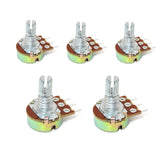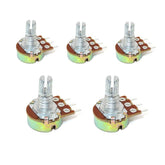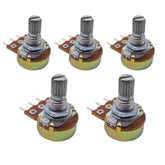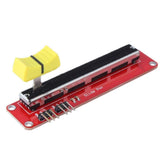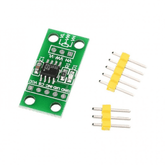Potentiometer: Definition, Types and Working Principle
Summary
A potentiometer is a three-terminal electrical device used to measure and control an electric current. It measures the potential difference between two of its terminals, usually in steps or fractions of a volt. Potentiometers have various useful applications, ranging from industrial automation to audio mixing and equalizing in sound equipment. This blog post will discuss the working principle of a potentiometer as well as different types along with their key features, helping you better understand this crucial component and its proper usage within your projects.
Introduction
A potentiometer is an essential electrical device used in many electronic applications. It's a variable resistor which allows for precise control over the flow of electricity, and can be adjusted to get specific results from the circuit it's connected to. Potentiometers are available in various sizes with different wattages and resistance values depending on their usage needs. They provide good accuracy when measuring voltages or currents, making them ideal for accurate electronics testing procedures such as calibrating oscilloscopes or determining AC/DC power levels accurately.
Additionally, these potentiometers come with built-in safety features that protect against accidental short circuits if they are accidentally touched by anything conducting high current like metal tools during repair operations - this feature adds more value to its use for precision instruments where circuitry damage must be avoided at all costs! Overall, strong build quality coupled with reliable performance make this device useful across industries ranging from automotive engineering systems to sophisticated medical equipment; no matter what type of application you're trying out there’s sure going to be a right kind of suitable potentionmeter out there waiting just for you!
What is a Potentiometer?
A potentiometer is an electronic device that detects a cell's internal resistance and its EMF (electromotive force). Additionally, it is utilized to contrast the EMFs of different cells. It can also be utilized as a variable resistor in most applications. These potentiometers are frequently used in creating electronic devices that let users modify electrical circuits to produce specific results. These potentiometers are used in enormous quantities to develop electronic equipment that allows electrical circuits to be adjusted to produce the desired outputs. However, radio volume controls and other audio-related electronic devices must be its most prominent application. It can be used in most applications as a variable resistor as well.

Fig. 1.a. Potentiometer symbol

Fig.1. b. Potentiometer symbol
How does a Potentiometer Work?
A rush of charged particles, such as electrons or particles, moving across an electrical channel or space is referred to as an electric flow. It is calculated as the average speed of an electric charge stream moving through a surface or into a control volume. Charge transporters, which can refer to a variety of particles depending on the transmitter, are moving particles. Electrons moving through a wire are frequently the charge carriers in electric circuits. A typical cell is linked across a long, uniform wire that serves as the potentiometer. In the real design, the long wire is divided into many segments, stacked next to one another, and joined at the ends by a substantial metal strip. Connecting a variable resistance (rheostat) device to the circuit makes it possible to change the current flowing through the wire. You can manually adjust the resistance to measure the potential difference. The amount of work required to move a charge from one location to another determines the potential difference between any two points in a circuit. A current will flow in the circuit whenever there is a potential difference. Using constant resistance, potentiometers adjust the location of sliding contacts. According to the following diagram, the output voltage of a potentiometer is the difference in voltage between the fixed and sliding contacts. The input voltage is applied throughout the resistor's length in a potentiometer.

Fig. 2. Potentiometer symbol
This extremely basic tool is used to calibrate ammeters, voltmeters, and watt metres as well as to compare the emf of two cells. A potentiometer's fundamental operating concept. A galvanometer connects two batteries in parallel. According to Fig 3, the positive and negative battery terminals are connected via a galvanometer andter, as well as the negative and positive battery terminals.

Fig. 3. Galvanometer connected with battery
The electrical resistance per unit length in a resistor remains constant throughout its whole length. As a result, the resistor's voltage drop remains constant throughout its whole length. If you change the rheostat, it causes the voltage drop.

Fig. 4. Galvanometer with Rheostat
The standard cell's negative terminal is connected to a galvanometer, and its positive terminal is connected to point A on the resistor. A sliding contact joins the other end of the galvanometer to the resistor, as shown in the diagram above. By adjusting this sliding end, a position like B is achieved, where there is no current flowing through the galvanometer and thus no deflection in the galvanometer. This indicates that all that is required to balance the emf of the standard cell in the resistor is the voltage that exists between points A and B. Now, if the distance between points A and B is L, we can write that a typical cell's emf is equal to Lv volts.
E = Lv Volts
Sensitivity of a potentiometer
The least possible variation that may be estimated with a potentiometer is the potentiometer sensitivity. The potential gradient value is mostly what determines its sensitivity (K). A potentiometer may calculate a smaller potential difference when the potential gradient value is low, which increases the potentiometer's sensitivity.
Therefore, for a given potential difference, the potentiometer's sensitivity can be increased by lengthening the potentiometer. The following factors can also lead to an increase in potentiometer sensitivity.
- By lengthening the potentiometer
- Using a rheostat, you can reduce the circuit's current flow.
- Both methods will aid in lowering the potential gradient's value & raising resistivity.
Potentiometer Types
There are three types of potentiometers: these are,
- Rotary potentiometer
- Linear Potentiometer
- Digital Potentiometer
1. Rotary potentiometer
These potentiometers, in which the wiper moves in a circle, are the most prevalent kind. These potentiometers are mostly employed to supply a portion of circuits with a variable voltage source. The volume control on a radio transistor, where the turning knob regulates the current supply to the amplifier, is the best example of a rotary potentiometer.

Fig. Rotary potentiometer
This type of potentiometer has two terminal contacts where a semi-circular model with a constant resistance can be placed. Additionally, it has a terminal in the centre that is connected to the resistance by a sliding contact and a turning knob. Turning the knob over the half-circular resistance moves the sliding contact. The voltage of this can be acquired between the sliding and resistance contacts on two contacts. Wherever level voltage control is required, these potentiometers are employed.
2. Linear Potentiometer:

The linear potentiometer is the same as the rotary potentiometer, but in this case, linear movement is used to move the sliding contact on the resistor rather than rotary movement. Here, a straight resistor's two ends are attached across the wiper in these varieties of potentiometers travels in a straight line. also referred to as a slider. The sliding contact in this potentiometer rotates linearly on the resistor, unlike the rotary-type potentiometer. The voltage source is linked across the two terminals of the resistor. A route connected through the resistor can be used to move a sliding contact on the resistor. One terminal of the resistor is linked to the slide, which is connected to the circuit's output on one end, while the other terminal is connected to the output. The voltage in a circuit is typically calculated using this type of potentiometer. It is utilized in sound and music equalizer mixing systems and to evaluate the internal resistance of battery cells.
3. Digital Potentiometer

A digital potentiometer, also known as a digipot, is a type of electronic component that performs analog potentiometer tasks. Like an analog potentiometer, the resistance between two terminals can be changed using digital input signals. There are two primary functional types: non-volatile, which maintains its set position using a storage method like flash memory or EEPROM, and volatile, which loses its set position if power is removed and is typically designed to initialize at the minimum position. The use of a digipot is much more complicated than that of a simple mechanical potentiometer, and there are numerous restrictions to be aware of. Despite this, they are frequently used for equipment calibration and factory adjustment, particularly in situations where mechanical potentiometer restrictions are problematic. In general, a digipot is resistant to the negative effects of mild long-term mechanical vibration.
Advantages
- High reliability
- higher precision
- Potentiometers are small and can fit many on a single chip.
- Minimal resistance drift
- Environmental factors including vibrations, dampness, shocks, and wiper contaminants have negligible effect on it.
- Tolerance of less than 1%
- Low power dissipation
Disadvantages:
- Not appropriate for high power applications and temperatures.
- In digital potentiometers, a bandwidth issue is relevant because of the parasitic capacitance of the electronic switches. It is the highest signal frequency that can pass through the resistance terminals with a wiper attenuation of less than 3 dB. The transfer equation is comparable to a low-pass filter's equation.
- Non-linearity in wiper resistance.
Applications:
- Comparing EMF and Battery cells: The main use of the potentiometer is the comparison of the battery cells with the standard battery cell.
- Applications in Motorsport - The usage of rotary and linear potentiometers in the automotive industry is common. Potentiometers are used to evaluate steering angle, gearshift, suspension, and throttle control on 2- and 4-wheel vehicles, among other things.
- In audio applications: A potentiometer is frequently used for volume control. A dual-gang potentiometer with one gang having a logarithmic taper and the other having an inverse logarithmic taper can be used to regulate the balance. The usage of faders in professional audio equipment is common.
- Steering Systems - Linear potentiometers and rotary potentiometers have been utilised for accurate measurement and angle sensing in steering systems on agricultural machinery, heavy-duty machinery, and some maritime vehicles.
- Dedicated Mountain Bikes - For sensing suspension fork and absorbing frame shock, our linear potentiometers were chosen.
- Potentiometers are utilized in the creation of special effects for cinema, especially regarding spectacular effects! Over the past few years, numerous high-profile films have employed our potentiometers.
- Rotary potentiometers are utilised on ticket barriers in public transportation, particularly those that resemble the London Underground. They are employed to make sure the gate is left open for the appropriate period and at the proper angle.
- Ramps and Moving Bridges: A potentiometer can be used to position a moving bridge or ramp precisely when it is necessary.
Conclusion
In this blog post we have learnt a potentiometer is a crucial component in the world of electronics, allowing for the precise control of electrical signals. From understanding how it works to exploring its different types, advantages, and applications. Whether you're an engineer, a DIY enthusiast, or simply curious about electronics, knowing about potentiometers is a must. So, embrace the power of potentiometers and take control of your electrical signals today!
If you appreciate our work don't forget to share this post and leave your opinion in the comment box.
Please do check out other blog posts about Popular electronics
Make sure you check out our wide range of products and collections (we offer some exciting deals!)
Excerpt
Frequently Asked Questions
1. What is a potentiometer used for?
A potentiometer is a three-terminal electrical component used to vary the electrical resistance in a circuit. It functions as a voltage divider, allowing a portion of the input voltage to appear at the output terminal. Potentiometers are commonly used as adjustable resistors in various electronic circuits and applications, including volume control in audio equipment, position sensing in robotics, and as sensors for various physical quantities such as light, temperature, and force. They can be manually adjusted with a knob or lever or used as a variable resistor controlled by an external voltage or current.
2. What is potentiometer and its principle?
A potentiometer controls the flow of current with the adjustment of resistance within a circuit. It operates through the enigma of a variable resistor, the resistance adjustable through the twisting of a dial or the sliding of a lever along a strip of resistance. The potentiometer finds itself frequently employed in situations such as controlling the volume in auditory apparatus or calibrating the instruments of science. The output of the potentiometer, a riddle wrapped in a mystery, is proportional to the angle of rotation of its controlling shaft, providing a straightforward yet effective method for controlling the flow of current in a circuit.
3. What is advantage of potentiometer over voltmeter?
Potentiometers and Voltmeters, both gauging voltage, but utilizing a potentiometer exhibits certain benefits. Unlike Voltmeters which simply measure voltage, Potentiometers enable you to make modifications to the voltage whilst measuring it. Resulting in immense precision when it comes to output control. Additionally, Potentiometers are constructed with sturdier materials, thus imparting longer lifespans. This makes them an ideal choice for industrial usage. They can also serve as an adjustable voltage divider. Proving to be an indispensable tool when it comes to calibrating instruments or setting reference voltages. To sum it up, Potentiometers offer versatility and dependability that supersedes Voltmeters, rendering it as the preferred option for many applications.
4. What is a potentiometer and how does it work?
A potentiometer is an adjustable resistor that varies resistance to control voltage in a circuit. It consists of three terminals: two fixed terminals and one movable wiper. By turning the knob or sliding the wiper, you can change the resistance and thus control the output voltage. Potentiometers are commonly used in volume controls, lighting dimmers, and sensor applications.
5. What are the main types of potentiometers?
The main types of potentiometers include linear and rotary potentiometers. Linear potentiometers change resistance along a straight path, while rotary potentiometers vary resistance by rotating a knob. Other types include digital potentiometers, which are often used in electronic circuits for precision adjustments, and trimmer potentiometers, designed for fine-tuning settings.
6. How is a potentiometer different from a rheostat?
A potentiometer has three terminals and can vary voltage across a circuit, while a rheostat has only two terminals and is used to control current. Potentiometers are typically used in applications requiring precise adjustments, whereas rheostats are suited for general current control in applications like dimming lights or adjusting motor speeds.
7. What are common applications of potentiometers?
Common applications of potentiometers include volume control in audio devices, brightness adjustment in lights, and user interface controls in electronic devices. They are also used in robotics for position sensing and in sensors for voltage adjustment in various machining processes. Their versatility makes them essential in many electronic projects.
8. How does a potentiometer measure EMF?
A potentiometer measures Electromotive Force (EMF) by balancing the unknown voltage against a known reference voltage. In this setup, the potentiometer allows for precise adjustments, enabling the user to find the point where no current flows, indicating that the voltages are equal. This measurement method is accurate and widely used in electrical applications.
9. What materials are used in potentiometer construction?
Potentiometers are typically constructed from materials like carbon, cermet, or conductive plastic for the resistive element. The wiper is usually made from metal, providing good conductivity. Insulating materials like plastic or ceramic are often used for the housing, ensuring durability and reliability in various environmental conditions.
10. How to connect a potentiometer in a circuit?
To connect a potentiometer in a circuit, identify the three terminals: one for the input voltage, one for the output voltage, and one to ground. Connect the input terminal to your voltage source, the output terminal to the device you are controlling, and the ground terminal to the negative side of the circuit. Adjust the potentiometer to change the output voltage as needed.
11. What are linear vs. rotary potentiometers?
Linear potentiometers have a straight slider that moves across a resistive track, changing resistance linearly. They are typically used in applications needing direct, linear adjustments. Rotary potentiometers, on the other hand, use a knob to rotate along a circular track, allowing for more compact designs. Both types serve similar functions but fit different mechanical needs.
12. How to test a faulty potentiometer?
To test a faulty potentiometer, first, disconnect it from the circuit. Then, use a multimeter set to measure resistance. Check the resistance across the terminals while adjusting the knob. If the resistance doesn’t change smoothly or shows discontinuities, the potentiometer is likely faulty and needs replacement.
13. Can potentiometers be used in Arduino projects?
Yes, potentiometers can be effectively used in Arduino projects. They can serve as analog sensors to control input values like brightness, volume, or motor speed. By connecting the middle wiper terminal to an analog input pin on the Arduino, you can read the varying voltage and react accordingly within your code.
1. What is a potentiometer used for?
A potentiometer is a three-terminal electrical component used to vary the electrical resistance in a circuit. It functions as a voltage divider, allowing a portion of the input voltage to appear at the output terminal. Potentiometers are commonly used as adjustable resistors in various electronic circuits and applications, including volume control in audio equipment, position sensing in robotics, and as sensors for various physical quantities such as light, temperature, and force. They can be manually adjusted with a knob or lever or used as a variable resistor controlled by an external voltage or current.
2. What is potentiometer and its principle?
A potentiometer controls the flow of current with the adjustment of resistance within a circuit. It operates through the enigma of a variable resistor, the resistance adjustable through the twisting of a dial or the sliding of a lever along a strip of resistance. The potentiometer finds itself frequently employed in situations such as controlling the volume in auditory apparatus or calibrating the instruments of science. The output of the potentiometer, a riddle wrapped in a mystery, is proportional to the angle of rotation of its controlling shaft, providing a straightforward yet effective method for controlling the flow of current in a circuit.
3. What is advantage of potentiometer over voltmeter?
Potentiometers and Voltmeters, both gauging voltage, but utilizing a potentiometer exhibits certain benefits. Unlike Voltmeters which simply measure voltage, Potentiometers enable you to make modifications to the voltage whilst measuring it. Resulting in immense precision when it comes to output control. Additionally, Potentiometers are constructed with sturdier materials, thus imparting longer lifespans. This makes them an ideal choice for industrial usage. They can also serve as an adjustable voltage divider. Proving to be an indispensable tool when it comes to calibrating instruments or setting reference voltages. To sum it up, Potentiometers offer versatility and dependability that supersedes Voltmeters, rendering it as the preferred option for many applications.
4. What is a potentiometer and how does it work?
A potentiometer is an adjustable resistor that varies resistance to control voltage in a circuit. It consists of three terminals: two fixed terminals and one movable wiper. By turning the knob or sliding the wiper, you can change the resistance and thus control the output voltage. Potentiometers are commonly used in volume controls, lighting dimmers, and sensor applications.
5. What are the main types of potentiometers?
The main types of potentiometers include linear and rotary potentiometers. Linear potentiometers change resistance along a straight path, while rotary potentiometers vary resistance by rotating a knob. Other types include digital potentiometers, which are often used in electronic circuits for precision adjustments, and trimmer potentiometers, designed for fine-tuning settings.
6. How is a potentiometer different from a rheostat?
A potentiometer has three terminals and can vary voltage across a circuit, while a rheostat has only two terminals and is used to control current. Potentiometers are typically used in applications requiring precise adjustments, whereas rheostats are suited for general current control in applications like dimming lights or adjusting motor speeds.
7. What are common applications of potentiometers?
Common applications of potentiometers include volume control in audio devices, brightness adjustment in lights, and user interface controls in electronic devices. They are also used in robotics for position sensing and in sensors for voltage adjustment in various machining processes. Their versatility makes them essential in many electronic projects.
8. How does a potentiometer measure EMF?
A potentiometer measures Electromotive Force (EMF) by balancing the unknown voltage against a known reference voltage. In this setup, the potentiometer allows for precise adjustments, enabling the user to find the point where no current flows, indicating that the voltages are equal. This measurement method is accurate and widely used in electrical applications.
9. What materials are used in potentiometer construction?
Potentiometers are typically constructed from materials like carbon, cermet, or conductive plastic for the resistive element. The wiper is usually made from metal, providing good conductivity. Insulating materials like plastic or ceramic are often used for the housing, ensuring durability and reliability in various environmental conditions.
10. How to connect a potentiometer in a circuit?
To connect a potentiometer in a circuit, identify the three terminals: one for the input voltage, one for the output voltage, and one to ground. Connect the input terminal to your voltage source, the output terminal to the device you are controlling, and the ground terminal to the negative side of the circuit. Adjust the potentiometer to change the output voltage as needed.
11. What are linear vs. rotary potentiometers?
Linear potentiometers have a straight slider that moves across a resistive track, changing resistance linearly. They are typically used in applications needing direct, linear adjustments. Rotary potentiometers, on the other hand, use a knob to rotate along a circular track, allowing for more compact designs. Both types serve similar functions but fit different mechanical needs.
12. How to test a faulty potentiometer?
To test a faulty potentiometer, first, disconnect it from the circuit. Then, use a multimeter set to measure resistance. Check the resistance across the terminals while adjusting the knob. If the resistance doesn’t change smoothly or shows discontinuities, the potentiometer is likely faulty and needs replacement.
13. Can potentiometers be used in Arduino projects?
Yes, potentiometers can be effectively used in Arduino projects. They can serve as analog sensors to control input values like brightness, volume, or motor speed. By connecting the middle wiper terminal to an analog input pin on the Arduino, you can read the varying voltage and react accordingly within your code.



